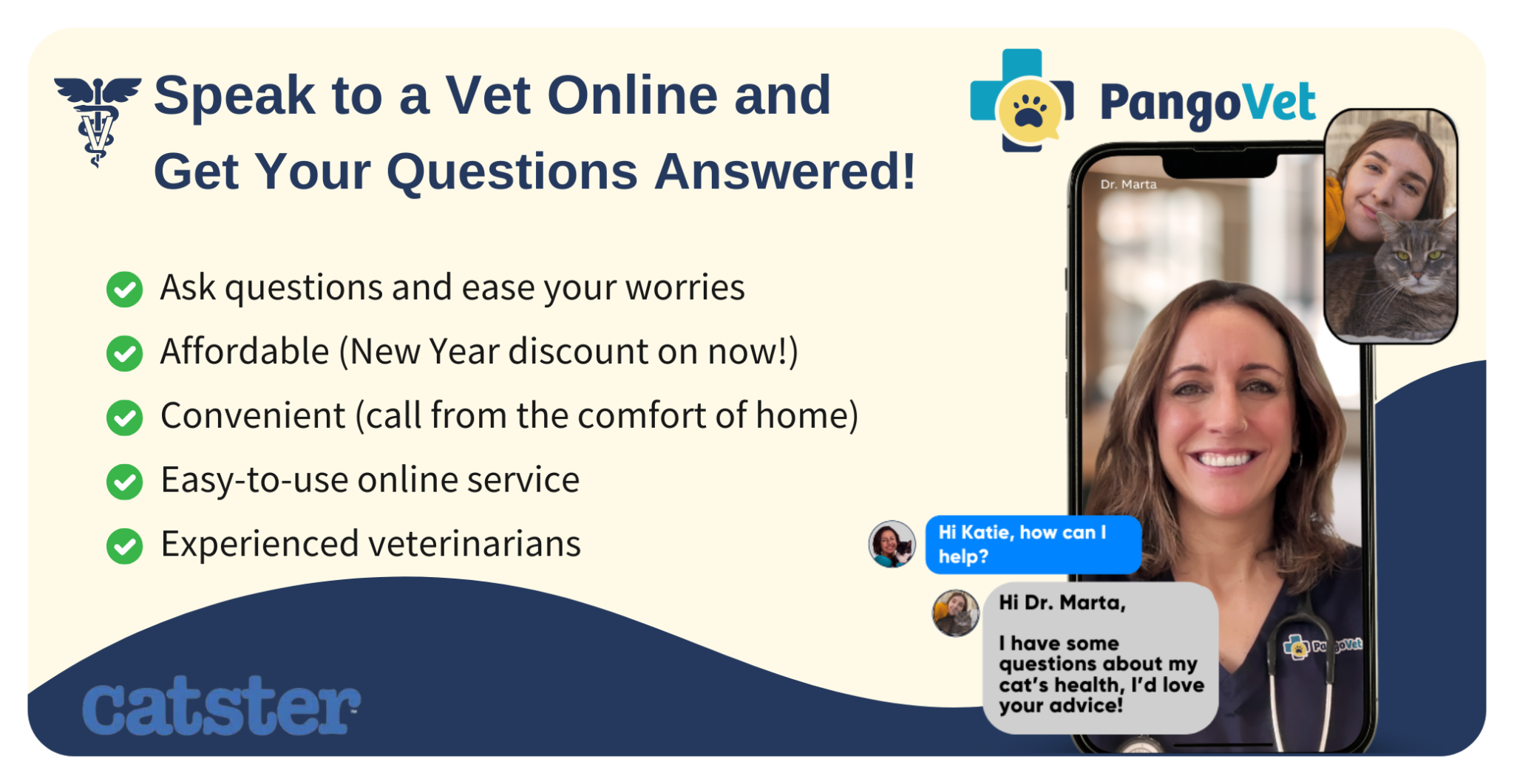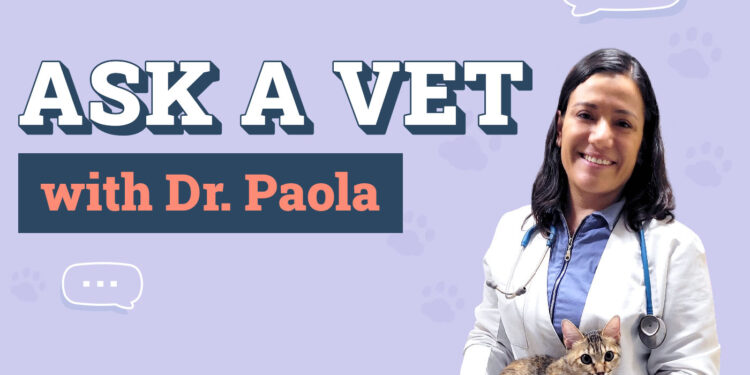Welcome to our “Ask Dr. Paola” collection, the place each Monday we deliver professional recommendation straight from Dr. Paola Cuevas (MVZ) to assist our readers higher perceive their cat’s well being and well-being.
Whether or not you’re a brand new pet guardian or a seasoned cat lover, Dr. Paola is right here to offer solutions to your most urgent questions. From diet suggestions and preventive care to troubleshooting widespread behavioral points, Dr. Paola is able to provide insights that can preserve your kitty completely happy, wholesome, and feline nice. Keep tuned for professional steering on a variety of subjects that matter most to you and your cat, so you can also make knowledgeable choices and supply the very best care on your furry companion.
Have a query? Ship it in right here!

Assist! My Rescue is Biting Her Tail!
“Expensive Dr. Paola,
Assist please. I’ve a 12-year-old spayed shorthair cat, Minnie. The issue: she is biting her tail (not taking part in!). I took her to our vet (who solely does routine vaccines and low-key stuff as she is almost retired). She expressed Minnie’s anal glands. One aspect was stable, and the opposite aspect was considerably liquid. Appeared to specific rather a lot. All of us thought that was the issue, but it surely didn’t make any enchancment. Any ideas or concepts on which path we must always go now? I admire your time.”
– Connie
Hello Connie,
Thanks for taking the time to explain what’s occurring with Minnie. It’s clear how a lot you care about her, and I can let you know’re doing all your greatest to unravel this. Tail biting, particularly in a senior cat like Minnie, is a habits that deserves shut consideration, significantly when it’s not playful and appears extra like a response to discomfort or irritation.
You had been completely proper to handle her anal glands first, particularly since one aspect was impacted with stable materials. Anal gland points in cats are much less widespread than in canine, however after they do happen, they’ll trigger important discomfort and even result in behaviors like tail biting or scooting. It’s necessary to know that these issues may be recurrent, particularly if the underlying trigger equivalent to irritation, irregular consistency of the stool or the gland contents, or continual irritation hasn’t totally resolved. Generally, even after expression, the glands can refill shortly or stay uncomfortable, which could clarify why Minnie hasn’t improved.
That stated, if she’s nonetheless persistently biting at her tail, it’s doable that there’s extra at play than simply her anal glands. In older cats like Minnie, we additionally contemplate different potentialities like spinal arthritis, nerve irritation, or feline hyperesthesia syndrome, which may make the tail and decrease again really feel twitchy, painful, or hypersensitive. These situations can mimic or overlap with gland points, so it’s necessary to take a broader look. A full-service vet who can consider her neurologically and orthopedically could be the subsequent greatest step. They could additionally advocate diagnostic imaging equivalent to X-rays to rule out spinal points, or probably blood work to examine for systemic causes of discomfort. Within the meantime, retaining an in depth eye on whether or not Minnie appears extra reactive to the touch close to her decrease again or tail base, or if the biting appears triggered by particular actions, can provide useful clues to your vet. If doable, attempt to additionally document the habits in a video which can present illustrative info. You’re clearly very attentive and devoted to her consolation, and he or she’s fortunate to have you ever in her nook.
Good luck,
– Dr. Paola
If it is advisable communicate with a vet however cannot get to at least one, head over to PangoVet. It is a web based service the place you may discuss to a vet on-line and get the recommendation you want on your pet — all at an inexpensive value!



Assist! How A lot Do I Feed My Cat?
“How a lot moist meals ought to I be feeding my cat, Child, day by day?“ – Michelle
Hello Michelle,
Thanks for reaching out together with your query about Child’s food regimen. Feeding the correct quantity of moist meals is crucial not just for sustaining a wholesome weight but in addition for supporting your cat’s total well-being, particularly since cats are typically extra hydrated when consuming moist meals in comparison with dry. The precise quantity Child wants is dependent upon a number of various factors. On common, a wholesome 8-pound grownup cat sometimes wants between 180 and 250 energy a day, however this will shift relying on her age, exercise degree, present weight, and whether or not she’s spayed. An incredible start line is utilizing a cat calorie calculator, which takes these components under consideration to estimate her each day wants. This device may be fairly correct when paired with common monitoring.
Most traditional 3-ounce cans of moist meals include between 70 and 100 energy. So, if Child’s each day requirement is round 200 energy, she’d possible want about two to 3 cans a day. However past simply counting energy, it’s useful to recurrently assess her physique situation rating, or BCS. This rating seems at her form and the way simply you may really feel her ribs and waistline. Consider it like tailoring a costume; you desire a match that’s neither too tight nor too unfastened. If Child is carrying a bit further or feels too lean, her portion sizes may be adjusted regularly. It’s particularly necessary to do it fastidiously and regularly, particularly when attempting to get a cat to drop a few pounds, as excessive modifications can put their well being at excessive threat. For those who’re uncertain about deciphering her BCS or utilizing a calorie calculator, you may contact one in every of our vets on-line via PangoVet, a teletriage service that may provide fast, personalised steering with no need an in-person go to. You’re doing an excellent job by being proactive; diet is such a strong a part of preventive care. Congratulations!
– Dr. Paola

Assist! My Kittens Ears Are Soiled!
“Expensive Dr. Paola,
My 5-month-old kitten, Raven, has a little bit of darkish grime on the within of her ears. Is that ordinary?” – Tiziana
Hello Tiziana,
Thanks on your considerate query about Raven. A small quantity of waxy particles inside a kitten’s ears can typically be regular, particularly if it’s mild brown and doesn’t have a robust odor. Nevertheless, if what you’re seeing seems extra like darkish espresso grounds, or if Raven has been scratching her ears or shaking her head greater than standard, it may very well be an indication of ear mites or an ear an infection. Kittens are significantly susceptible to those situations, particularly in the event that they’ve had publicity to different animals or got here from a shelter surroundings.
As a result of ear points may be uncomfortable and should worsen if left untreated, it’s greatest to have her ears examined by a veterinarian. Ear mites, for instance, are very treatable, however they do require a correct prognosis and prescription treatment. If Raven isn’t exhibiting indicators of discomfort and also you’re simply noticing a little bit of wax, a delicate clear with a vet-recommended ear cleaner could be all she wants, although I’d nonetheless recommend having her ears checked to make sure the eardrum is undamaged. A vet can look deep into the ear canal utilizing an otoscope, examine the eardrum’s integrity, and select the appropriate sort of cleaner or treatment if wanted. Till then, it’s greatest to not try cleansing the ears at dwelling, particularly when you’re uncertain whether or not there’s discomfort or underlying an infection.
Finest,
Dr. Paola
This text is part of our weekly Ask Dr. Paola collection



